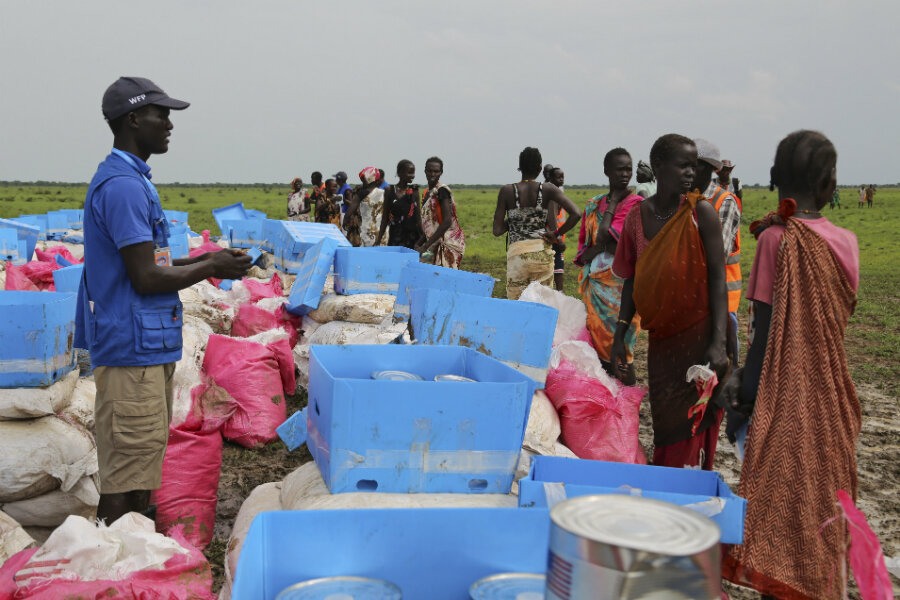As famine threatens, an unprecedented global challenge – and response
Loading...
| Paris
The challenge is unprecedented. Twenty million people in four countries face famine in the next six months, UN Secretary-General Antonio Guterres warned this week, unless the world steps in with $4.4 billion.
“The situation is dire,” he said. “Millions of people are barely surviving in the space between malnutrition and death” in war-wracked Yemen, Somalia, South Sudan, and Nigeria.
But the international response has been unprecedented, too. Even though donors are not yet giving anything like enough to cope with the crisis, they are offering money more quickly than ever before. And they are funding innovative approaches to humanitarian relief that promise to save hundreds of thousands of lives.
“We have a good fighting chance to avert outright famine” in Somalia, says Gabriella Waaijman, who runs operations in the Horn of Africa for the Norwegian Refugee Council. “We are dealing with a much more responsive donor system.”
Six years ago, a quarter of a million Somalis died of starvation. In 2011, “by the time we declared famine … half of those who [ultimately] died had already died,” UN humanitarian chief Stephen O’Brien said on Wednesday. “We are sounding the alarm now so that we can actually make the difference.”
In the space of a few days, the European Union and the British government had given $336 million between them to South Sudan and Somalia.
Experts have been predicting the four famines for months as they have watched warning signs mount. Famine was officially declared in parts of South Sudan on Monday; Yemen, northeastern Nigeria, and Sudan are just one notch down on a five-level scale, at “emergency.”
So although the world is reacting more quickly than in 2011, it needs to get faster still – and figure out how to overcome what experts call “the CNN effect,” or the difficulty of galvanizing Western publics and governments before they see the suffering on their television screens. By that time, it is too late. Farmers have eaten their seed-corn, sold their tools, and seen their livestock perish.
“The funding system for humanitarian aid is broken,” says Debbie Hillier, a policy adviser to Oxfam, the international aid organization, based in Oxford, England. "We are stuck in a Kafka-esque situation where humanitarians can see a crisis coming but they cannot mobilize significant funding. "We need institutional donors to be more forward-leaning."
Rethinking old practices
Still, there are signs that donors are not only reacting more quickly to acute emergencies, but that some governments and the agencies they fund are changing their whole approach to humanitarian aid in a bid to bypass the “CNN effect.”
The buzzword these days in humanitarian circles is “resilience.” That means aid workers not just doling out food to starving villagers in an emergency, but talking to them in normal times about what they would need to withstand shocks.
It might be a bore-hole to provide water when the rains fail; it might be an all-weather road to the nearest market town; it might be micro-credits to help women set up small shops or farmers buy donkey carts.
“Agencies and donors are aligning long-term development programs with short-term emergency response programs” that have traditionally been distinct, says Rob Bailey, a food security expert at the London-based think tank Chatham House. “That means fundamentally revising the humanitarian system.”
It also means donors have to promise funds over a longer period of time than they are used to. Most humanitarian agencies are funded crisis to crisis, as emergencies come up, but governments are increasingly willing to pay for multi-year projects, says Ms. Waaijman.
“Resilience is not built in six months,” she points out. “It’s a multi-sectoral and multi-year effort.”
Donors such as USAID are also proving themselves more flexible in the way they spend their money, allowing swift reallocation of development funds to emergency purposes without lengthy bureaucratic procedures.
That means that an aid agency could quickly suspend a program to build up cattle herds if a threat of drought loomed, and convert it into a program to slaughter animals and preserve their meat.
The value of cash
Then there's the shift away from goods and toward cash. Currency is easier to transport and distribute than 100-lb. sacks of sorghum, and it gives recipients the freedom to choose and buy what they need most.
“Ten years ago the default was food,” says Ms. Hillier. “Now we are moving to cash as the default” aid mechanism.
The impact of such reforms is limited; “it will take time for them to become mainstream,” cautions Bailey, and joining up the dots between development work and emergency response will be hard in countries like South Sudan and Yemen until the fighting there stops.
With front lines fluid and emergencies breaking out all over, humanitarian work in South Sudan is “a traveling circus of life-saving responses,” says Waaijman, but in a situation of perpetual crisis “we have no other choice.”
And even that is not always possible, says Jonathan Pedneault, a South Sudan researcher with Human Rights Watch in Nairobi, Kenya. “Humanitarians and their assets have come under repeated attack so they are cautious about setting up shop,” he says.
“You cannot disassociate the famine from the political factors that created it – war, displacement, and abuses,” says Mr. Pedneault. “There is nothing natural about this.” But neither South Sudan's President Salva Kiir nor opposition leader Riek Machar have suffered any consequences for their troops’ barbarous behavior, “so they grew bolder and that led to today’s situation.”
When wars cause famine, agrees Hillier, “you need outside political pressure as well as money” to deal with them.
But if droughts are inevitable, famines are not, she says.
“Famines are always man-made, always a choice,” she says. “But we have the tools to address this, aid does work, and we can solve it.”






